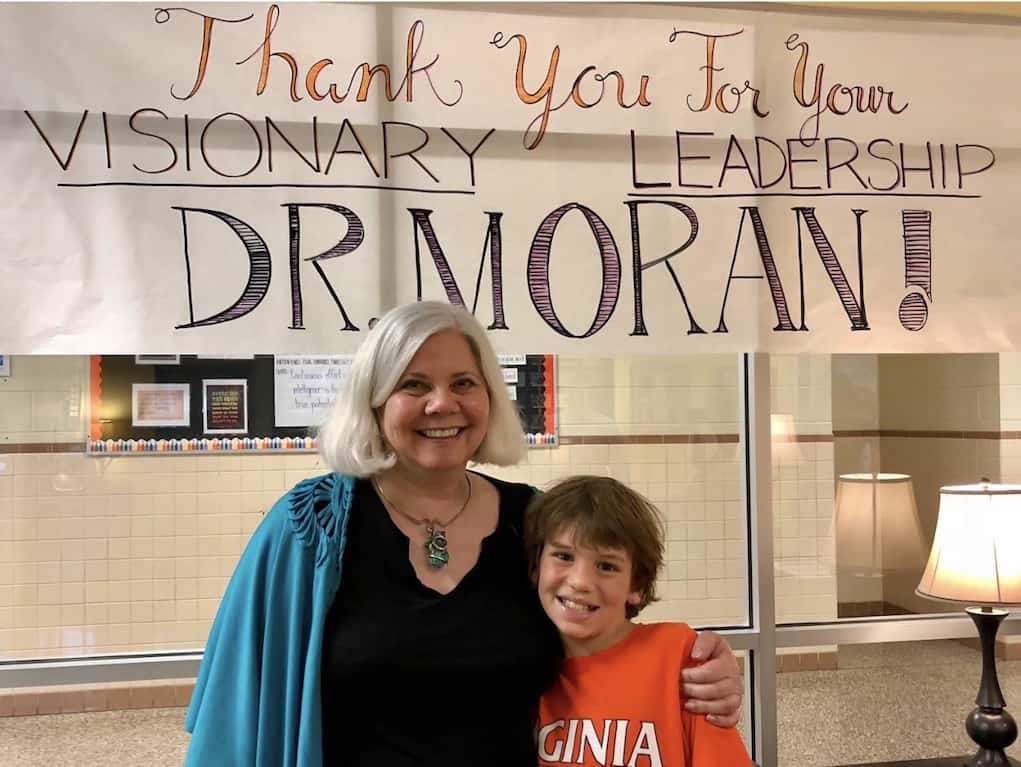Find a Way to Yes: 9 Leadership Lessons from Pam Moran

Albemarle County surrounds historic Charlottesville, Virginia home of Thomas Jefferson, James Monroe and UVA. The sprawling county is diverse and growing.
Pam Moran has been a staff member of Albemarle County Public Schools for 32 years. After a dozen years as superintendent, Dr. Moran is retiring. She’s quietly become one of America’s leading educators not because she’s outspoken but because the work she leads is so compelling.
On a recent visit my colleague Emily Liebtag and I observed nine lessons from Moran’s leadership.
1.Ask good questions. Doug Granger, first year principal at Agnor-Hurt Elementary (below) said the key to leadership in Albemarle is asking good questions. Doug learned humility as a band teacher where, after a few years, many students are better on their instruments that the teacher. As an assistant principal, Granger saw Dr. Moran lead a learning culture by asking good questions.
Moran said, “We need to visit schools to keep learning.” Last year she sent a group to Design 39 in Southern California, one of our favorite K-8 schools. It was one of the inspirations for the current round of remodels. Moran is also inspired by studying broadly and visiting business and new retail formats.
 2. Find a way to yes. Rather than a compliance culture, Pam starts with a bias toward yes. (Check out her TED Talk on getting to yes.)
2. Find a way to yes. Rather than a compliance culture, Pam starts with a bias toward yes. (Check out her TED Talk on getting to yes.) Lisa Molinaro, Principal at Woodbrook Elementary, shared that it is Pam’s dedication to “finding a way to yes” that has kept her around for so long and motivated her to think differently.
Lisa Molinaro, Principal at Woodbrook Elementary, shared that it is Pam’s dedication to “finding a way to yes” that has kept her around for so long and motivated her to think differently.
Pam is an expert at navigating boundaries and obstacles that get in the way of a bold idea an educator has and helps empower those around her to find ways to get to a “yes”. Pam shared, “I’ve come to the conclusion after a lot of years that you can’t change the system without changing the system.”
3. Learner choice. Third and fourth grade students at Agnor-Hurt Elementary learn is a big open six classroom block. During the morning meeting, teachers described learning options (displayed in a shared Google doc on a Smart board):
- Science: Work on your design project on matter, electricity or energy
- Recreate: Create a Minecraft world about Virginia in the 20th century, include the shift from rural to urban
- Build: Research the Battle of Yorktown and build a model
- Share: Sit down with someone and tell a story they don’t already know about you
- Write: author another page for our “Diary of a multiage kid”
- Read: Go to Epicbooks and read something
- Clean: go organize and clean somewhere in our multiage pod
- Marketplace: work on your marketplace project
 4. Spaces that support learning options. In 2015 Pam’s provocateur in chief Ira Socol lead a process that identified seven pathways to lifelong learning. The first three outlined a commitment to learner choice and comfort. When a learner walks into a room, says Ira, they should have a choice of several sitting or standing opportunities.
4. Spaces that support learning options. In 2015 Pam’s provocateur in chief Ira Socol lead a process that identified seven pathways to lifelong learning. The first three outlined a commitment to learner choice and comfort. When a learner walks into a room, says Ira, they should have a choice of several sitting or standing opportunities.
The spectacular new multiage space at Woodbrook Elementary (below) features varied floor and ceiling heights that make the large space quiet and intimate.  Ira talks about spaces that mimic caves, campfires, and watering holes. The inclusive spaces create entry points for all students and incorporate technology choices to overcome disabilities and inabilities.
Ira talks about spaces that mimic caves, campfires, and watering holes. The inclusive spaces create entry points for all students and incorporate technology choices to overcome disabilities and inabilities.
In the middle school library (below) where students can eat lunch there are couches, chairs, tables, and high tops. Every library and makerspace features electricity from the ceiling.  5. Active and authentic learning. Albemarle schools feature authentic project-based learning that help students develop and demonstrate higher order thinking and knowledge acquisition while they pursue personal interests by making real choices in project forms and media.
5. Active and authentic learning. Albemarle schools feature authentic project-based learning that help students develop and demonstrate higher order thinking and knowledge acquisition while they pursue personal interests by making real choices in project forms and media.
The MESA academy at Albemarle High (below) includes a maker-infused curriculum where students design and build tools and products.  Albemarle Tech, a new high school (more of an unschool) opening this fall in a business center, will provide flexible personalized schedules, student-directed projects, and work-based learning.
Albemarle Tech, a new high school (more of an unschool) opening this fall in a business center, will provide flexible personalized schedules, student-directed projects, and work-based learning.
6. Connected learning. Albemarle schools support student-centered learning with school provided devices and Wi-Fi available throughout the county. Students make choices about the technologies they use to research, produce and present learning.
Elementary schools feature an international portal, a virtual field trip room where every class takes a few project-related journeys each year.
7. Don’t let a plan get in the way of a good idea. The Albemarle team has a well developed strategy in place but Moran doesn’t let a plan block opportunity. “We pivot fast to stand up new idea,” explained Moran.
When it comes to pilot projects, Pam suggests, “Aim small. Miss small.” She favors an iterative approach to innovation.
The most recently opened multiage space located in Woodbrook Elementary (above) has only been open for about two weeks. The space was ready and despite being near the end of the school year and not intending to use the space until the following school year, the team and Pam decided to test it out.
8. Make innovation systemic. Encouraging innovation–finding a way to say yes–can produce inequities across a school system. Moran has made sure that each school has some change or innovation. “If not systemic, all kids won’t get the benefit,” said Moran.
In addition to an innovation culture, Moran has created a culture that seeks equity. She credits restorative practices (i.e., build relationships, solve problems) for the lack of discipline problems in Albemarle schools.
Making innovation systemic means that change is not optional and that it won’t always be comfortable. “I’ve come to the conclusion after a lot of years that you can’t change the system without changing the system,” said Moran.
9. Develop talent. There are thoughtful HR policies in Albemarle but visiting schools with Pam makes evident talent development strategy number one–love. She loves her kids and her staff. You feel it a see it in every interaction.
The culture and talent run deep in Albemarle. The team is ready to step up. Moran’s deputy Matt Haas will be taking over as superintendent next month. He’s been leading the High School 2022 initiative. Debora Collins stepped into Matt’s role. Pam knows the true test of her leadership will be evident a few years from now when the team she developed has started making their own imprint.
“There’s more good stuff going on than people know about,” said Moran about public education in America. We certainly agree. It’s because of people like Pam. Thank you for your visionary leadership Dr. Moran!
For more see
- Getting Smart on Reinventing Education: How a Pittsburgh Network is Remaking Learning
- Leading A Student-Centered Agenda: 10 Lessons from Mark Benigni
This post was originally published on Forbes.
Stay in-the-know with all things EdTech and innovations in learning by signing up to receive the weekly Smart Update.







Giedre Vanessa de Castro Benatto
I can see very clearly how it works. And it works! These nine lessons are to be tattooed on everyone's heart!
Replies
Erik Day
Thanks Giedre, we're glad you found this useful!